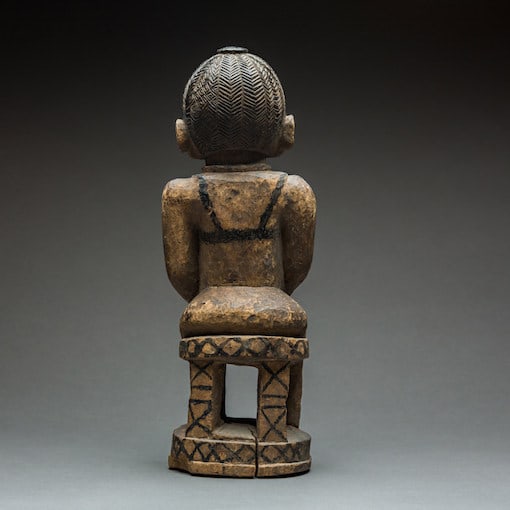Igbo Sculpture of a Woman, 1850 CE - 1910 CE
Wood
14 x 36.8 cm
5 1/2 x 14 1/2 in
5 1/2 x 14 1/2 in
LSO.207
Further images
The Igbo (Ibo) of the Northern Niger River Delta are one of the largest and most important tribal groups in West Africa. They are culturally highly complex, with a political...
The Igbo (Ibo) of the Northern Niger River Delta are one of the largest and most important tribal groups in West Africa. They are culturally highly complex, with a political system based upon a loose form of chiefdom/kingship in some areas, and a democratic panel of decision-makers in others. Social life was usually governed by a number of secret societies. Their main god is Chukwu (literally “Great Spirit”), the creator of the world, who is also linked to the sun and all that grows and lives. Social conduct is governed by Ogu-na-Ofo, spirits who defend the innocent against unjust charges. If a guilty person appeals to them for help, they will be cursed by Amadioha (the god of thunder and lightning). There are numerous other gods that deal with issues as diverse as Ahia Njoku (yams) to Ikenga (fortune and industry) and Agwu (medicine men). Each person has a god named Chi, which is essentially an embodiment of a person’s fate.
The Igbo are known for their artistic diversity, due to the wide range of environments and local histories to which their culture is exposed. Standard sculpture includes Alusi figures – large, public figures designed to embody the spirits of significant gods – and also Ikenga figures, which are kept on personal altars in private homes.
This figure represents a woman seated on a stool. She is very full-figured, with subtle and well-executed carving to the body outline. She is naked except for a necklace, what appears to be a brassiere, and boots, implying that this piece dates to a period when such items were scarce and desirable. The face is very strong, with a wide trilobate nose, thin lips, triple-oval eyes and eyelashes carved in with a very fine chisel. The pupils and eyebrows are carefully low-lighted with dark paint. The hairstyle - or perhaps hat - is low above the eyes, and is very complex, with vertical bands of chevrons surmounted by a small secondary bun arrangement. The left posterior aspect of her headpiece is decorated with diamond shapes. The stool and the integral base of the figure is decorated with cross hatching in dark brown paint. This clearly represents a woman of some importance - perhaps a chief's wife - judging from her seated position and also her western-style clothing.
The Igbo are known for their artistic diversity, due to the wide range of environments and local histories to which their culture is exposed. Standard sculpture includes Alusi figures – large, public figures designed to embody the spirits of significant gods – and also Ikenga figures, which are kept on personal altars in private homes.
This figure represents a woman seated on a stool. She is very full-figured, with subtle and well-executed carving to the body outline. She is naked except for a necklace, what appears to be a brassiere, and boots, implying that this piece dates to a period when such items were scarce and desirable. The face is very strong, with a wide trilobate nose, thin lips, triple-oval eyes and eyelashes carved in with a very fine chisel. The pupils and eyebrows are carefully low-lighted with dark paint. The hairstyle - or perhaps hat - is low above the eyes, and is very complex, with vertical bands of chevrons surmounted by a small secondary bun arrangement. The left posterior aspect of her headpiece is decorated with diamond shapes. The stool and the integral base of the figure is decorated with cross hatching in dark brown paint. This clearly represents a woman of some importance - perhaps a chief's wife - judging from her seated position and also her western-style clothing.









